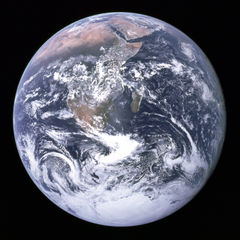Fleet of spacecraft could block catastrophic global warming
Fleet of spacecraft could block catastrophic global warming
mongabay.com
November 9, 2006
A space sunshield could be used to cool the Earth in an emergency scenario in which global warming reaches crisis levels, according to an astronomer at the University of Arizona.
In a paper to be published in the Proceedings of the National Academy of Sciences, Roger Angel, Director of the Steward Observatory Mirror Laboratory and the Center for Astronomical Adaptive Optics, proposes launching “trillions of small free-flying spacecraft a million miles above Earth” into the L-1 orbit, an orbit aligned with the sun.
A news release from NASA explains:
-
The spacecraft would form a long, cylindrical cloud with a diameter about half that of Earth, and about 10 times longer. About 10 percent of the sunlight passing through the 60,000-mile length of the cloud, pointing lengthwise between the Earth and the sun, would be diverted away from our planet. The effect would be to uniformly reduce sunlight by about 2 percent over the entire planet, enough to balance the heating of a doubling of atmospheric carbon dioxide in Earth’s atmosphere.
|
Earth as viewed from Apollo 17 |
While researchers have proposed various strategies for cooling the planet, Angel’s plan — based on an idea hatched by James Early of the Lawrence Livermore National Laboratory in 1989 — doesn’t rely on space assembly or scattering particles in the upper atmosphere.
“The earlier ideas were for bigger, heavier structures that would have needed manufacture and launch from the moon, which is pretty futuristic,” Angel said. “I wanted to make the sunshade from small ‘flyers,’ small, light and extremely thin spacecraft that could be completely assembled and launched from Earth, in stacks of a million at a time. When they reached L1, they would be dealt off the stack into a cloud. There’s nothing to assemble in space.”
NASA explains further:
-
The lightweight flyers designed by Angel would be made of a transparent film pierced with small holes. Each flyer would be two feet in diameter, 1/5000 of an inch thick and weigh about a gram, the same as a large butterfly. It would use “MEMS” technology mirrors as tiny sails that tilt to hold the flyers position in the orbiting constellation. The flyer’s transparency and steering mechanism prevent it from being blown away by radiation pressure. Radiation pressure is the pressure from the sun’s light itself.
The total mass of all the fliers making up the space sunshade structure would be 20 million tons. At $10,000 a pound, conventional chemical rocket launch is prohibitively expensive. Angel proposes using a cheaper way developed by Sandia National Laboratories for electromagnetic space launchers, which could bring cost down to as little as $20 a pound.
The sunshade could be deployed by a total 20 electromagnetic launchers launching a stack of flyers every 5 minutes for 10 years. The electromagnetic launchers would ideally run on hydroelectric power, but even in the worst-case environmental scenario with coal-generated electricity, each ton of carbon used to make electricity would mitigate the effect of 1000 tons of atmospheric carbon.
|
Dr. Robert Angel. Courtesy of the University of Arizona. |
“The concept builds on existing technologies,” Angel said. “It seems feasible that it could be developed and deployed in about 25 years at a cost of a few trillion dollars. With care, the solar shade should last about 50 years. So the average cost is about $100 billion a year, or about two-tenths of one percent of the global domestic product.”
While the two-tenths of one percent figure is lower than other estimates projected by scientists, Angel warns that the sunshield is not a permanent solution.
“The sunshade is no substitute developing renewable energy, the only permanent solution. A similar massive level of technological innovation and financial investment could ensure that,” he said. “But if the planet gets into an abrupt climate crisis that can only be fixed by cooling, it would be good to be ready with some shading solutions that have been worked out.”
This article uses excerpts and quotes from a November 3, 2006 NASA news release.
















